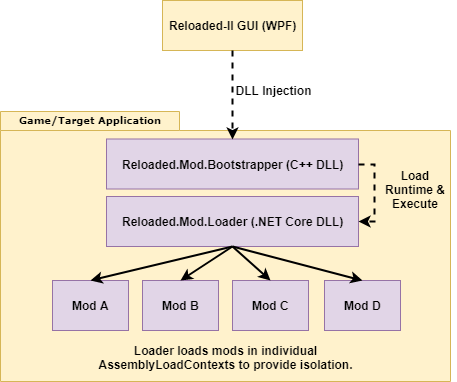High Level Architecture

Code Injection Steps
The typical bootstrapping mechanism for Reloaded II looks like the following:
- Launcher starts the application as a suspended state.
- Launcher uses DLL injection to inject the Loader Bootstrapper.
- The Bootstrapper loads the .NET runtime and the Loader.
- The Loader parses configurations and loads individual mods.
- Process is resumed by Launcher.
Mods are loaded using a shared interface, implemented by mods. This works by forcing mods to load the same version of the interface that the main Loader was compiled against.
Detecting Reloaded II
Reloaded II is not intended to bypass DRM or anti-cheating software. It makes no attempts to hide itself.
Reloaded II can be easily detected through one of the following two methods.
-
Module List.
IfReloaded.Mod.Loader.dllis found in the process' module list, there's a good chance that Reloaded is present inside the target process. -
Memory Mapped File.
Alternatively, you can try opening a memory mapped file handle toReloaded-Mod-Loader-Server-PID-{a}where{a}is the PID of the process you want to check. If the handle is valid, Reloaded is running inside the target process.
Service: Local Server
Injected Reloaded instances inside the target process host a local UDP server which can easily be interacted with by connecting.
The library Reloaded.Mod.Loader.Server can be used to interact with the server.